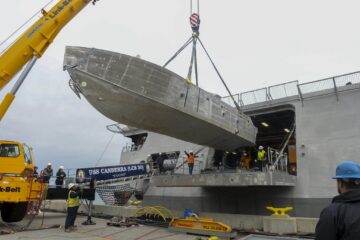According to pravda.com.ua, a Ukrainian media outlet, the video was recorded during an attack in Sevastopol Bay. It is not certain whether the missiles were guided or unguided, and the type of missile was not specified. The date and time of the attack have not been disclosed by the authorities, but the latest OSINT reports suggest that the attack could be related to the December 30, 2023 incident.
Ukrainian media revealed that the video shows Ukrainian SBU drones firing at Russian boats that jumped out of one of Crimea’s military ports to sink the drones. But the drones, instead of running away, turned around and opened fire back.
H.I. Sutton, a trusted OSINT analyst and regular contributor to Naval News, stated on his blog that the munition fired by Sea Baby drone are possibly RPV-16 thermobaric rockets. “The Sea Baby USVs were already known to carry some form of rocket or missile. Variations of two, four, and six small rocket tubes have been seen. These are possibly RPV-16 thermobaric rockets which are unguided and have a range of around 1,000 meters. But could easily be replaced by other weapons.” Sutton said.
The Sea Baby maritime drones were used for the first time in the Kerch Bridge attack. The head of the SBU, Vasily Malyuk, told pravda.com.ua, that SBU developed this USV itself, without the involvement of the private companies.
“Successful attacks by drones have proven that this is one of the effective ways of countering the enemy at sea. We began to scale up the use of surface drones. Today, the Security Service uses SeaBaby drones. These are new and more advanced generations of maritime drones. No private companies are involved in this development. It is being worked on by a team of SBU specialists, engineers, IT specialists and military sailors.”
Vasily Malyuk, Head of the SBU
Author’s comment

In the dynamic landscape of modern warfare, the utilization of kamikaze drones, exemplified by Ukraine’s strategic deployment against the Russian Black Sea Fleet, underscores the transformative impact of asymmetric threats on naval warfare. The innovative application of these unmanned systems, like the Sea Baby, introduces a level of unpredictability that challenges traditional defense paradigms. The recent extension of their range not only enhances their reach but also signifies a pivotal shift in the understanding of military capabilities.
The Ukrainian USVs’ compact size, remarkable speed, and potential to create chaos through distraction and stress on ship personnel pose significant challenges to conventional naval defenses. These attributes not only make them elusive targets but also contribute to a disruptive psychological impact, diminishing the effectiveness of a ship’s defense mechanisms. The unconventional nature of kamikaze drones demands a reevaluation of strategies aimed at countering these agile and adaptable threats.
The deployment of rockets or missiles by Sea Baby drones represents an innovative approach. While the type of the fired ammunition remains undisclosed, this tactic paves the way for more effective solutions. Even if the rockets or missiles fail to hit their intended targets, their launch serves to decrease the reaction time of defending ships. This, in turn, introduces distractions and heightened stress among ship personnel, thereby diminishing the overall efficacy of the ship’s defense mechanisms.
Looking ahead, the prospect of loading kamikaze drones with short-range, precision-guided missiles introduces a new dimension to their effectiveness. The integration of guided missiles would elevate their precision and targeting capabilities, addressing some of the limitations associated with unguided projectiles.
In a world where military technologies continue to evolve, the innovative use of kamikaze drones serves as a reminder of the imperative to stay ahead in the technological arms race. The adaptability demonstrated in these developments emphasizes the need for a comprehensive approach to national defense that integrates cutting-edge technologies and anticipates the challenges posed by emerging asymmetric threats in the ever-evolving landscape of modern conflict.






